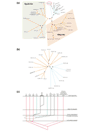The two faces of Alba: the evolutionary connection between proteins participating in chromatin structure and RNA metabolism
- PMID: 14519199
- PMCID: PMC328453
- DOI: 10.1186/gb-2003-4-10-r64
The two faces of Alba: the evolutionary connection between proteins participating in chromatin structure and RNA metabolism
Abstract
Background: There is considerable heterogeneity in the phyletic patterns of major chromosomal DNA-binding proteins in archaea. Alba is a well-characterized chromosomal protein from the crenarchaeal genus Sulfolobus. While Alba has been detected in most archaea and some eukaryotic taxa, its exact functions in these taxa are not clear. Here we use comparative genomics and sequence profile analysis to predict potential alternative functions of the Alba proteins.
Results: Using sequence-profile searches, we were able to unify the Alba proteins with RNase P/MRP subunit Rpp20/Pop7, human RNase P subunit Rpp25, and the ciliate Mdp2 protein, which is implicated in macronuclear development. The Alba superfamily contains two eukaryote-specific families and one archaeal family. We present different lines of evidence to show that both eukaryotic families perform functions related to RNA metabolism. Several members of one of the eukaryotic families, typified by Mdp2, are combined in the same polypeptide with RNA-binding RGG repeats. We also investigated the relationships of the unified Alba superfamily within the ancient RNA-binding IF3-C fold, and show that it is most closely related to other RNA-binding members of this fold, such as the YhbY and IF3-C superfamilies. Based on phyletic patterns and the principle of phylogenetic bracketing, we predict that at least some of the archaeal members may also possess a role in RNA metabolism.
Conclusions: The Alba superfamily proteins appear to have originated as RNA-binding proteins which formed various ribonucleoprotein complexes, probably including RNase P. It was recruited as a chromosomal protein possibly only within the crenarchaeal lineage. The evolutionary connections reported here suggest how a diversity of functions based on a common biochemical basis emerged in proteins of the Alba superfamily.
Figures



References
-
- Lodish H, Berk A, Zipursky SL, Matsudaira P, Baltimore D, Darnell J. Molecular Cell Biology. New York: WH Freeman and Co; 1999.
-
- Dorman CJ, Deighan P. Regulation of gene expression by histone-like proteins in bacteria. Curr Opin Genet Dev. 2003;13:179–184. - PubMed
-
- Luger K, Mader AW, Richmond RK, Sargent DF, Richmond TJ. Crystal structure of the nucleosome core particle at 2.8 A resolution. Nature. 1997;389:251–260. - PubMed
-
- Sandman K, Bailey KA, Pereira SL, Soares D, Li WT, Reeve JN. Archaeal histones and nucleosomes. Methods Enzymol. 2001;334:116–129. - PubMed
MeSH terms
Substances
LinkOut - more resources
Full Text Sources
Other Literature Sources
Miscellaneous

